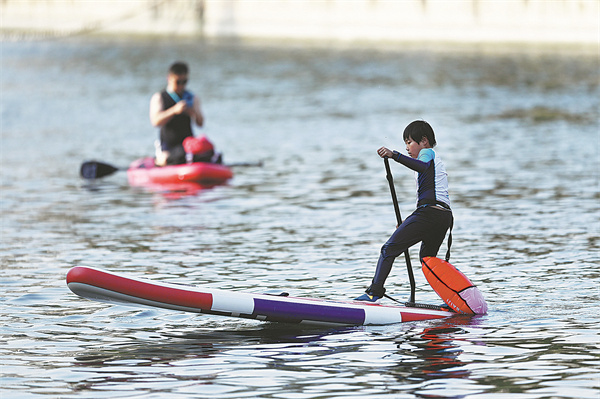Shifting consumer preferences, rising disposable incomes, urbanization and increasing health consciousness have propelled the growth of China’s camping and outdoor sports industries. By 2025, the outdoor sports product market is projected to reach approximately US$33.8 billion[1]. As of September 2024, China recorded over 177,000 outdoor-related enterprises, with more than 42,000 new registrations marking a nearly 50% year-on-year increase [2].
Following events such as the 2022 Beijing Winter Olympics, national enthusiasm for snow and ice sports has increased. During the 2023-2024 snow season, 264 million people participated in snow sports. This growing interest has propelled China’s winter sports industry from US$42 billion in 2015 to US$133 billion in 2024[3], with forecasts predicting US$172 billion by 2025[4].
Historically, outdoor activities in China were primarily limited to niche groups or rural communities, constrained by limited infrastructure and lower consumer spending on leisure activities. However, urbanization, increased disposable incomes, and a stronger emphasis on health and wellness have transformed these industries into mainstream economic drivers. The pandemic further accelerated this shift, as travel restrictions and social distancing measures prompted people to seek outdoor escapes closer to home.
Social media platforms, especially Douyin, have played a pivotal role in driving this trend. Outdoor-related sales have increased by 70% and brands such as Pelliot and Kolon Sport seeing transaction volumes climb by over 100%[5]. Livestreamed outdoor experiences and sport-related content gained over 140 million views, while sports and outdoor footwear and apparel brands accounted for 38.5% of total transactions over the past five years[6]. As eco-consciousness grows, demand for sustainable and environmentally friendly outdoor products continues to rise, cementing the sector’s role as a key driver of China’s consumer economy.
Camping, once a niche activity, has become a mainstream leisure pursuit. Families and young professionals embrace it as a way to escape urban pressures and reconnect with nature. Recreational fishing has witnessed a surge in participation, supported by improved infrastructure, dedicated fishing zones, and the influence of social media platforms like Douyin, where fishing-related content has gained significant traction. The fishing equipment market is projected to generate $2.42 billion in revenue in 2024, with an annual growth rate of 7.35% expected from 2024 to 2029[7]. Regions like Jiangsu Province have become hotspots for recreational fishing, witnessing a 73% increase in participation in 2023[8], reaching nearly 14 million participants. The fishing rods segment alone generated $89.8 million in 2024 and is set to grow to $128.7 million by 2030, with a CAGR of 6.2%[9]. Together, these activities highlight a broader societal shift towards health, wellness, and sustainable leisure pursuits.
Paddleboarding, also known as stand-up paddleboarding (SUP), has rapidly gained popularity in China, particularly among urban residents seeking new recreational activities. The global stand-up paddleboard market is expected to reach USD 296.6 million by 2029, growing at a compound annual growth rate (CAGR) of 2.9% from 2023 to 2029[10]. On Xiaohongshu, posts related to paddleboarding have exceeded 60,000, with a fivefold increase in 2021 compared to the previous year[11]. Similarly, on Douyin, posts tagged with “SUP” have garnered over 360 million views, with the most popular post receiving over 143,000 likes[12].

The landscape of outdoor activities in China today is shaped by two dominant demographic forces: the silver generation and younger urban consumers. Older adults, particularly those aged 50 and above, are emerging as a key driver of the outdoor recreation boom. They view activities like fishing, hiking, and gentle camping as pathways to healthier, more fulfilling lifestyles[13]. This generation benefits from increased leisure time, rising disposable incomes, and a growing cultural emphasis on active aging. Meanwhile, younger demographics, including Millennials and Gen Z, continue to fuel trends such as paddleboarding, wild camping, and skateboarding, with Millennials favouring fishing and camping while the post-2000 generation embraces more adventurous pursuits. Social media platforms like Douyin have played a significant role in amplifying these trends across all age groups. The silver generation and younger enthusiasts are reshaping China’s outdoor recreation market, highlighting its broad appeal and long-term growth potential.
China’s outdoor sports industry has become a powerful driver of tourism, blending leisure and travel into a thriving economic force. The sector’s total consumption reached nearly $137 billion in 2022, highlighting its significant contribution to the country’s economy[14]. Participation in outdoor sports surged by 19% year-on-year in early 2024, with activities like hiking, cycling, and camping taking the lead[15]. The integration of sports and tourism is particularly evident in local events such as marathons and trail runs, which have boosted regional economies and drawn thousands of visitors[16]. Cities across China are leveraging this momentum, collaborating with outdoor brands and social media influencers to promote unique travel experiences. Rural regions, too, have benefited immensely—sports tourism initiatives in areas like the Dabie Mountains have increased household incomes by an average of 19,865 yuan[17]. As urbanization accelerates and health consciousness rises, outdoor sports tourism is poised to play an even more prominent role in China’s leisure and travel sectors, creating sustainable growth opportunities for both urban and rural communities.
Make sure to check out the rest of our Top Trends in China for 2025.
[1]https://english.www.gov.cn/archive/statistics/202401/05/content_WS6597a30fc6d0868f4e8e2c74.html
[2]https://english.www.gov.cn/archive/statistics/202401/05/content_WS6597a30fc6d0868f4e8e2c74.html
[4] https://www.china-briefing.com/news/chinas-winter-sports-market-outlook-and-opportunities
[5] https://www.chinadaily.com.cn/a/202412/11/WS6758f6f6a310f1265a1d2452.html
[6] https://www.chinadaily.com.cn/a/202412/11/WS6758f6f6a310f1265a1d2452.html
[7] https://www.statista.com/outlook/emo/toys-hobby/sports-equipment/fishing-equipment/china
[9] https://www.grandviewresearch.com/horizon/outlook/fishing-rods-market/china/
[10] https://m.gelonghui.com/p/871148
[11] https://www.chinadaily.com.cn/a/202211/04/WS63646b5ea310fd2b29e803c7.html
[12] https://www.chinadaily.com.cn/a/202211/04/WS63646b5ea310fd2b29e803c7.html
[13] https://pmc.ncbi.nlm.nih.gov/articles/PMC6188614
[14] https://www.china-briefing.com/news/chinas-outdoor-sports-industry-growth-potential-trends-and-opportunities/
[15] http://en.people.cn/n3/2024/0923/c90000-20221925.html
[16] http://en.people.cn/n3/2024/0923/c90000-20221925.html
[17] https://www.jorae.cn/EN/10.5814/j.issn.1674-764x.2024.06.013?refererToken=9ab8978e13644d2db6e4a796fed970d4















